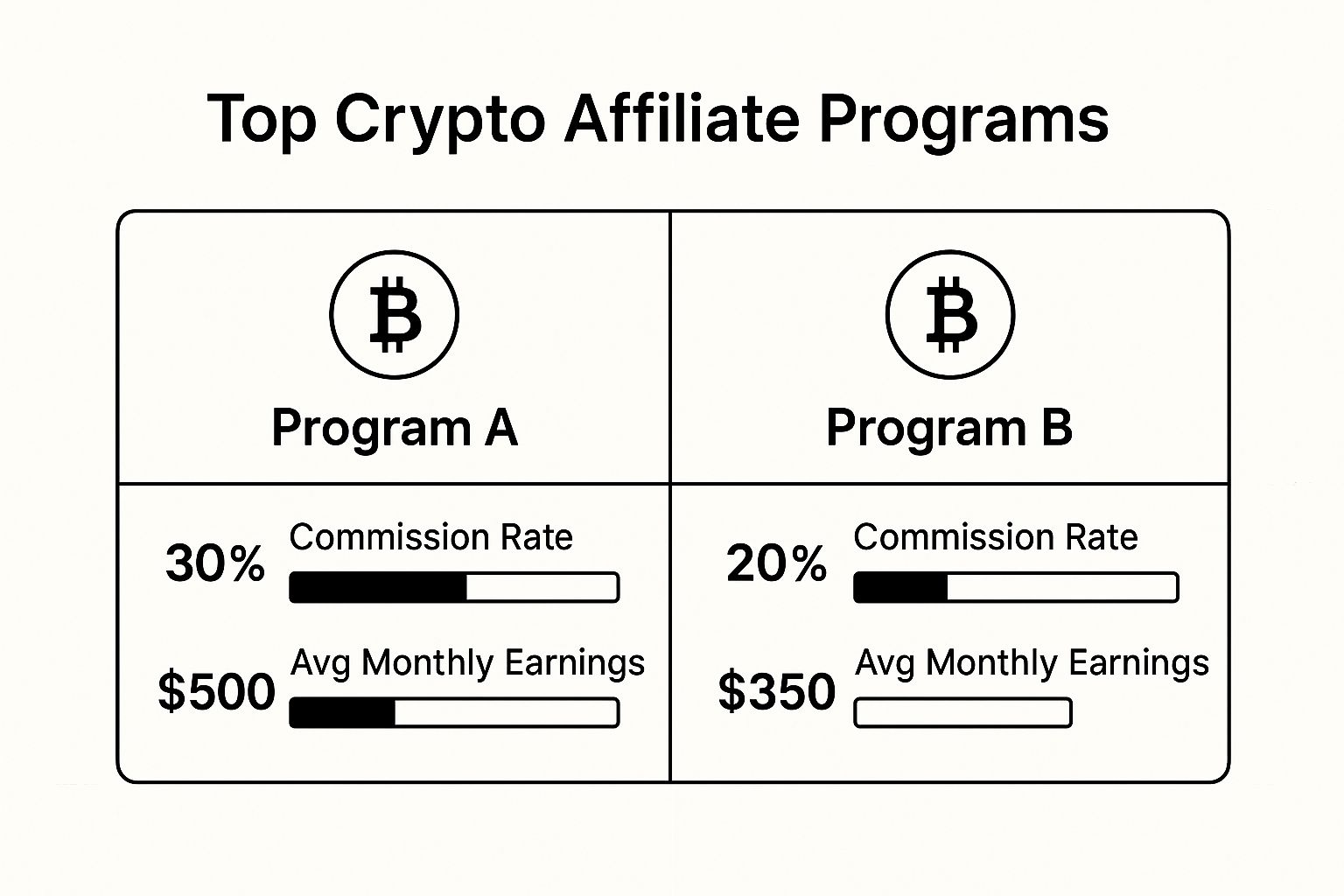Build a Winning Cryptocurrency Affiliate Program

Ever heard of a crypto affiliate program? It's basically a way for you to get paid for spreading the word about a crypto project you like. You’re like a brand ambassador, and for every new person you bring in using your special link, you get a commission—usually in crypto or cash.
So, What Exactly Is a Crypto Affiliate Program?

Think of it as a referral program built for the Web3 space. A crypto company—like an exchange, a wallet, or a new dApp—partners up with people like you (the affiliate). They hand you a unique, trackable link to share with your audience.
When someone clicks your link and signs up or buys something, the company knows you sent them. In return, they give you a cut of the action. It’s a simple, powerful way to build a grassroots marketing army driven by people who genuinely use and love the product.
Core Components of a Crypto Affiliate Program at a Glance
To really get a feel for how these programs work, it helps to break them down into their essential parts. The table below gives you a quick snapshot of the key pieces that make the whole system tick.
| Component | What It Is | Why It Matters |
|---|---|---|
| The Unique Link | A personalized URL given to each affiliate. | This is how the system tracks who sent which customer. No unique link, no commission. |
| Tracking & Attribution | A system (usually using cookies) that connects a new user back to the affiliate who referred them. | It ensures you get credit for your referrals, even if they don't sign up right away. |
| The Conversion Event | The specific action that triggers your commission (e.g., a sign-up, a first trade, a deposit). | This defines what you need your referrals to do for you to get paid. It's the goal line. |
| The Commission Payout | The reward you receive for a successful conversion, paid in crypto or fiat. | This is your income! It can be a one-off payment, a percentage of revenue, or even a recurring fee. |
Understanding these four pillars is the first step. Once you see how they connect, the power of this marketing model becomes crystal clear.
The Nuts and Bolts
The whole system is pretty straightforward once you see it in action. It all hinges on that unique link. This isn't just any old URL; it has a special tracker tied directly to you.
When someone clicks it, a small tracking file (a cookie) is saved on their device. This lets the project's system know that you were the one who sent them. Then, when that person completes the goal—what we call a "conversion event"—the system gives you the credit.
A conversion could be anything from signing up for a newsletter to making their first trade. Once that happens and it's verified, you get your commission payout. For a real-world look, check out an example of an existing crypto affiliate program to see how these mechanics play out.
It’s a Win-Win-Win
The beauty of the cryptocurrency affiliate program is that everyone comes out ahead.
The crypto project gets new, high-quality users without spending a fortune on ads that might not work. They only pay for actual results. You, the affiliate, earn passive income just by sharing something you’re already passionate about.
And the new user? They find a cool project through someone they trust. It’s this three-way street of value that makes affiliate marketing such a durable and effective strategy for growing in the Web3 world.
Why Affiliate Programs Are a Web3 Growth Engine

So, why are so many Web3 projects swapping out expensive, hit-or-miss ad campaigns for affiliate marketing? It's pretty simple: affiliate programs are a tried-and-true engine for real, sustainable growth. They trade the old "spray and pray" ad model for something way more authentic.
Let's imagine a new crypto exchange, "AlphaSwap," trying to make a name for itself in a crowded market. They could blow their budget on social media ads and get a bunch of expensive clicks from users who don't stick around. They just aren't hitting the right audience.
Instead, AlphaSwap tries a different play. They launch a cryptocurrency affiliate program and bring on a dozen respected crypto educators and YouTubers. These folks already have loyal audiences who listen to what they have to say. Now, instead of a random ad, these communities hear about AlphaSwap from someone they trust. That's an instant connection.
Suddenly, marketing isn't just a cost. It's a performance-based investment.
Building Trust in a Trustless World
In a world built on decentralized trust, old-school corporate advertising just doesn't land. Web3 natives are notoriously skeptical. They’re much more likely to check out a new dApp because a creator they follow or a community leader they respect gave it a nod.
An affiliate isn't just a walking billboard; they're a trusted filter. Their recommendation means something because their reputation is on the line. That kind of authentic, word-of-mouth endorsement is priceless, and it's how you build a real, long-term user base.
By rewarding genuine advocates, you turn your most passionate users into a decentralized marketing team. This creates a powerful feedback loop where community growth and product adoption fuel each other.
The Power of Performance-Based Costs
One of the biggest wins of a crypto affiliate program is how much sense it makes financially. With traditional ads, you pay upfront for views or clicks and just hope for the best. You could drop $10,000 on a campaign and end up with zero engaged users.
Affiliate marketing completely flips that script.
- Pay for Results, Period: You only cut a check when an affiliate actually delivers, whether that's a new sign-up or a user making their first trade. This makes your customer acquisition cost (CAC) totally predictable and tied directly to results.
- Growth That Scales With You: As you bring on more affiliates, your reach explodes—but your marketing team's workload doesn't. It’s a model that grows right alongside your project, naturally.
- Laser-Targeted Reach: Affiliates have already done the heavy lifting of building niche communities. You get to tap directly into groups of pre-qualified people, from DeFi power users to NFT collectors.
This model is a game-changer for projects, especially startups, helping them build real momentum without draining the treasury. To get a better handle on this, check out our guide on how to get momentum for your project.
A Partnership Where Everyone Wins
This isn't just a one-way street. A solid affiliate program creates a thriving ecosystem for the affiliates themselves. It gives content creators, developers, and community managers a real way to monetize their influence and expertise. By promoting projects they genuinely believe in, they can earn a steady, passive income.
Looking back, you can see how much these programs have matured. Back in 2014-2017, commissions were pretty modest. Fast forward to today, and you’ll see major platforms offering up to 50-80% on trading fees, allowing creators to turn their passion into a full-blown business. Of course, for these programs to really work as growth engines, they need affiliates who know their way around digital marketing, including mastering SEO lead generation for growth.
How To Structure Your Affiliate Commissions
Alright, let's get into the part everyone really cares about: the money. How you decide to pay your partners is easily one of the most important decisions you'll make when building your crypto affiliate program. The right structure can light a fire under your affiliates and drive insane growth. The wrong one? It can kill your program before it even gets off the ground.
Think of it like this: your commission structure is the core reason an affiliate will promote your project over someone else's. It needs to be compelling, sustainable for your business, and tied directly to your goals. There's no magic "best" model here—the right choice depends entirely on your product and the user actions you want to drive.
Cost Per Acquisition (CPA): The Finder's Fee Model
The simplest and most straightforward approach is Cost Per Acquisition (CPA). It’s basically a one-time finder's fee. You pay a flat, fixed amount when a new user completes a specific action you care about.
That action, or "conversion," could be anything you define as valuable:
- A new user signs up and completes KYC.
- Someone makes their first deposit over a certain amount.
- A customer buys a product, like a hardware wallet.
CPA is great because it's so predictable. You know your exact cost for every new customer, which makes budgeting a whole lot easier. For instance, a hardware wallet company might offer a 10% commission on every wallet sold through an affiliate link. The affiliate knows exactly what they’ll make per sale, and the company knows its customer acquisition cost down to the penny.
This model is a perfect fit for projects with a clear, one-off transaction where the initial sale is the main event.
A well-defined CPA model offers crystal-clear ROI. You pay a set amount for a tangible result, making it a straightforward way to scale user acquisition without complex revenue calculations. If you need a hand with this, you can learn more about how to measure marketing ROI in our detailed guide.
Revenue Share: The Long-Term Partnership
Revenue Share (or "rev-share") is a totally different ballgame. Instead of a one-time payout, you’re giving the affiliate a slice of the revenue generated by the users they bring in. This can last for a set period or even for the user's entire lifetime on your platform. It’s less of a finder’s fee and more like a long-term royalty.
Take a crypto exchange, for example. They might offer an affiliate 30% of all trading fees generated by a referred user for their first year. The affiliate isn't just paid for the signup; they’re pushed to find active, high-volume traders who will generate fees month after month.
This model is a fantastic way to align your goals with your affiliates'. They’re directly motivated to find high-quality, engaged users because their long-term paycheck depends on it. This is the go-to model for any platform with recurring revenue, like exchanges, lending protocols, or blockchain games with in-app purchases.
The infographic below shows how different commission rates can affect average earnings, really highlighting the trade-offs between different program types.

As you can see, a bigger commission rate doesn't automatically mean bigger earnings. The quality and activity of the users they bring in are what really move the needle, especially in a rev-share setup.
Comparing Common Crypto Affiliate Commission Models
Choosing between CPA, Revenue Share, or something in between can be tough. This table breaks down the core differences to help you decide what makes the most sense for your project and the kind of affiliates you want to attract.
| Model | How It Works | Best For | Pros | Cons |
|---|---|---|---|---|
| CPA (Cost Per Acquisition) | A one-time, fixed payment for a specific user action (e.g., sign-up, first deposit). | Projects with a single, high-value conversion point (e.g., hardware wallets, paid newsletters). | Predictable costs, easy for affiliates to understand, quick payouts. | Can attract low-quality users focused on the initial action only. |
| Revenue Share | Affiliates earn a percentage of the revenue generated by their referred users over time. | Platforms with recurring revenue streams (e.g., crypto exchanges, DeFi protocols, P2E games). | Aligns affiliate incentives with long-term business goals, encourages high-quality referrals. | Unpredictable costs, earnings can be slow to build for affiliates. |
| Hybrid (CPA + Rev-Share) | Combines a smaller upfront CPA payment with a lower ongoing revenue share percentage. | Businesses that want to reward both the initial conversion and long-term user value. | Best of both worlds: provides immediate reward and long-term incentive. | More complex to track and manage, can have lower rates for each component. |
| Tiered | Commission rates increase as affiliates hit specific performance milestones (e.g., number of referrals). | Mature programs looking to motivate and retain top-performing affiliates. | Gamifies the program, strongly incentivizes top performers, builds loyalty. | Can feel unattainable for new or smaller affiliates, requires robust tracking. |
Ultimately, the best model is the one that fuels the kind of growth you're aiming for.
Hybrid And Tiered Models: Getting Creative
The good news is you don’t have to stick to just one. Many of the most successful crypto affiliate programs mix and match to create a structure that gives them the best of both worlds.
- Hybrid Models: These combine CPA and Revenue Share. You could offer a small flat fee for every qualified signup (CPA) plus a smaller percentage of their ongoing trading fees (rev-share). This gives affiliates an immediate reward for their efforts while still pushing them to find users who will stick around.
- Tiered Rewards: This structure is all about motivating your best people. You increase an affiliate's commission rate as they hit certain goals. For example, an affiliate might start at 20% rev-share for their first 50 referrals, but that rate jumps to 30% once they pass that milestone. Tiers turn it into a game and give your top partners a clear path to earning more, which keeps them loyal and hungry for more.
So, What Makes a Crypto Affiliate Program Actually Good?

Ever wonder what separates a forgettable cryptocurrency affiliate program from one that people genuinely rave about? It’s not just about dangling a high commission rate. The real magic is in the details—the thoughtful features that make the whole experience feel smooth, trustworthy, and genuinely profitable for your partners.
A truly great program is built to empower affiliates, not just track them. It starts with one crucial ingredient: total transparency. If an affiliate can't see how their hard work translates into clicks and conversions, their motivation is going to dry up. Fast.
A Killer Dashboard They Can Actually Use
Think of the dashboard as the affiliate's command center. It’s where they can see performance at a glance, figure out what’s clicking (literally), and make smart decisions to boost their numbers. Guesswork is the enemy of a good partnership; clarity is what builds trust for the long haul.
A solid dashboard offers way more than a simple click count. It needs to give them the full picture with detailed analytics on:
- Clicks and Impressions: How many eyeballs are they actually getting on their links?
- Conversion Rates: Which campaigns are turning those clicks into real sign-ups or sales?
- Earnings Breakdown: A crystal-clear view of commissions from each referral. No mystery math.
- Payout History: A transparent log of all payments—past, present, and pending—to show you're reliable.
Giving them this level of insight shows you respect their effort and are invested in their success. It turns a simple transactional relationship into a true strategic alliance.
High-Quality Marketing Assets That Don't Suck
Expecting your affiliates to create all their promotional content from scratch is a massive ask and a recipe for burnout. The best programs make it ridiculously easy for partners to start promoting on day one by providing a library of polished, on-brand marketing materials.
It's like handing them a fully stocked toolkit. You remove all the friction and ensure your brand’s message stays consistent and professional, no matter who is sharing it.
A well-equipped affiliate is an active affiliate. When you give them ready-to-use assets, you're not just making their life easier—you're empowering them to promote your project like a pro across all their channels.
Here are a few must-haves for their toolkit:
- Banners and Graphics: Professionally designed visuals in all the right sizes for blogs, websites, and social media.
- Email Templates: Pre-written copy they can easily tweak for their own newsletters.
- Social Media Copy: Ready-to-post blurbs, tweets, and talking points that nail your brand voice.
- Product Guides: In-depth info that helps them truly understand and explain your project's value.
Fair Commissions and a Generous Cookie Window
Okay, let's talk money. The financial incentives have to be competitive, and the commission structure should be clear, fair, and rewarding. The crypto space is all over the map with this, with top programs offering rates anywhere from 10% to 80% depending on what they're selling. An exchange like MEXC might offer a massive 80% cut of trading fees, while a hardware wallet company like Ledger will more realistically offer 10-15% per sale. You can get a good feel for the competition by checking out an analysis of affiliate programs on Bitbo.io.
But the commission rate is only half the story. The cookie duration is just as important. This is just a fancy term for how long the tracking cookie stays active after someone clicks an affiliate's link.
If your cookie duration is a stingy 24 hours, your affiliate gets nothing if their referral waits a day to sign up. A longer window—like 30, 60, or even 90 days—shows you value their influence over the entire customer journey, not just that first impulsive click. It’s a huge sign of good faith.
Finding and Partnering With the Right Affiliates
So, you’ve built an incredible cryptocurrency affiliate program. That's great, but a program with no affiliates is like throwing a party and forgetting to send invitations. Now comes the fun part: getting the right people in the door. This isn't just about blasting out emails to anyone with a "crypto" bio. It's about building real, lasting partnerships that drive actual growth.
Think about it—the best affiliates aren't just paid advertisers. They're trusted voices, the people your target audience already listens to for advice. Your mission is to find partners whose content and values genuinely resonate with what your project is all about.
Identifying Your Ideal Affiliate Partners
Before you even think about outreach, you need a crystal-clear picture of who you're looking for. The perfect affiliate partner usually fits into one of a few key profiles. Your first move should be to create a "dream list" of people already making waves in your specific corner of the crypto world.
Who should be on your list?
- Crypto Bloggers and Content Creators: These are the deep-dive specialists—the ones writing detailed guides, reviews, and tutorials. Their audience hangs on their every word because they trust their expertise.
- YouTube and Podcast Hosts: In the world of crypto, video and audio are king. Creators hosting interviews, market analysis shows, or "how-to" segments have a direct, personal line to their followers, making their recommendations incredibly effective.
- Community Leaders and Influencers: These are the people driving the conversation on X (formerly Twitter), Telegram, and Discord. They're on the front lines, and their opinions can make or break community sentiment.
- Existing Power Users: This one is huge, and so often overlooked. Who better to promote your project than the people who already use it and love it? Their praise is authentic because it comes from real-world experience.
The most successful affiliate partnerships feel less like a transaction and more like a collaboration. Focus on finding people who would genuinely use and love your product even if they weren't getting paid.
Crafting Outreach That Actually Gets a Response
Alright, you've got your list. Now it's time to reach out. But be warned: generic, copy-paste emails are a fast-track to the spam folder. The affiliates you really want are constantly flooded with partnership requests. Your message needs to stand out.
The secret? Make it personal. Show them you've actually done your homework. Mention a specific article they wrote or a video you loved, and explain why you think your project is a perfect match for their audience. Keep your message short and sweet, clearly outline the benefits (like your killer commission structure), and make it ridiculously easy for them to say "yes."
Managing and Nurturing Your Affiliate Relationships
Getting someone to sign up is just the beginning. The long-term health of your cryptocurrency affiliate program really depends on how you treat your partners after they're on board. This is a relationship, not a one-off deal. Your job is to arm them with everything they need to win.
Start with a clear, easy-to-understand affiliate agreement so everyone's on the same page. Keep things fresh by running special promotions, like a commission boost for a week, to keep them motivated. Most importantly, dig into your affiliate dashboard data. See who your top performers are and get on a call with them. Ask what's working, what's not, and what you can do to help. That personal touch is what transforms a good affiliate into a superstar advocate for your brand.
Common Pitfalls to Avoid When Launching Your Program
Learning from others' mistakes is a superpower in the fast-moving world of Web3. Launching a cryptocurrency affiliate program is a huge step, but a few common traps can easily trip you up before you even get going. Think of this as your "what not to do" checklist to make sure your program is built to last.
One of the biggest blunders I see is setting completely unsustainable commission rates. It’s tempting, I get it. You want to flash huge payouts to attract the best affiliates right out of the gate. But if those numbers aren't backed by a solid financial model, you'll be forced to slash them later—and that’s the fastest way to break trust and watch your top partners walk away.
Vague Terms and Unclear Rules
Another classic mistake? Fuzzy or incomplete terms of service. Ambiguity is the enemy of any good partnership. If your affiliates don't have a crystal-clear rulebook, you’re just asking for disputes, fraud, and a whole lot of headaches.
Your terms need to spell everything out. No gray areas.
- Allowed Promotional Methods: Can they run paid ads? Are there brand keywords they absolutely can't bid on?
- Conversion Criteria: What specific action actually triggers a commission? Be brutally precise here.
- Payment Schedules: How and when do they get paid?
- Clawback Policies: Are there situations where a commission can be taken back?
To head off misunderstandings and legal messes down the road, having a solid affiliate agreement template is non-negotiable. It defines the relationship, protects you both, and keeps things fair.
Neglecting Your Affiliates' Needs
Finally, don’t fall for the "set it and forget it" trap. Launching the program is just the starting line. The most successful programs treat their affiliates like genuine partners, not just another line on a spreadsheet. That means giving them the tools and support they actually need to win.
A common failure point is assuming affiliates will figure everything out on their own. If you don't provide them with quality marketing assets, clear communication, and responsive support, their motivation will quickly fade.
Look at the big exchanges like Binance and Coinbase. Their programs kill it not just because of commissions—which can hit 50% of trading fees—but because they’ve built a whole ecosystem for their partners. The affiliate space is crowded now, with everything from wallets to tax tools vying for attention. To stand out, you have to offer more than just a check.
You can explore how some of the top crypto affiliate programs are structured on RockWallet.com for some great examples. Steer clear of these common pitfalls, and you’ll set your program up for long-term health and create an environment where your affiliates can truly thrive.
Frequently Asked Questions About Crypto Affiliate Programs
Jumping into crypto affiliate marketing for the first time? You're bound to have a few questions. We see the same ones pop up time and again, so we’ve put together some quick answers to help you get started on the right foot.
What Is the Best Payout Method for Crypto Affiliates?
Honestly, there's no single "best" way—it really boils down to what your affiliates prefer and what your program can support. That said, direct crypto payments are hands-down the most popular option in this space.
- Crypto Payouts (e.g., BTC, ETH, USDT): They're fast, cheap, and just feel right for Web3. Paying out in a stablecoin like USDT is a smart move to sidestep all the price volatility.
- Fiat Payouts (e.g., Bank Transfer, PayPal): These are the old-school options. They work, but they're often slower and come with higher fees. Still, they're a good fallback for affiliates who want to cash out right away.
The best approach? Offer both. Giving people the choice between crypto and fiat makes your program more attractive to a much wider pool of partners.
How Do I Handle Affiliate Payouts in Different Tokens?
Paying out in a bunch of different cryptocurrencies might sound like a headache, but it’s actually pretty standard. The trick is to have a system that can juggle multiple wallets across different blockchains. Just be crystal clear in your program's terms about which tokens are on the table for payouts.
Pro tip: Stick to the big, well-known cryptocurrencies for payouts. They offer the liquidity and stability your affiliates will appreciate. However, paying partners in your own project's native token can be a killer incentive—it gives them real skin in the game.
If you're still getting up to speed, figuring out the difference between a coin and a token is a great place to start. You can dive deeper into what crypto tokens are in our guide to get a solid handle on the assets you'll be working with.
Are Crypto Affiliate Programs Legal and Compliant?
Yes, they are, but you absolutely have to stay on top of compliance. The rulebook for crypto is always changing and looks completely different from one country to the next. The golden rule is to be transparent and follow the financial promotion laws wherever your affiliates and their audiences live.
That means you have to:
- Be Transparent: Make sure your affiliates are upfront about their partnership and the fact that they might earn a commission. No secrets.
- Avoid Misleading Claims: Don't let affiliates make wild promises about getting rich quick or guaranteed profits. That's a huge red flag.
- Know Your Jurisdiction: Get familiar with the advertising rules for crypto and financial services in your most important markets.
Seriously consider talking to a lawyer who knows the crypto space. It’s a smart investment to make sure your program stays on the right side of the law.
Ready to build and automate your Web3 growth engine without the headache? Domino provides the no-code toolkit to launch, manage, and scale your quests and affiliate rewards in minutes. Launch your first campaign with Domino today!
Level Up Your dApps
Start using Domino in minutes. Use automations created by the others or build your own.
